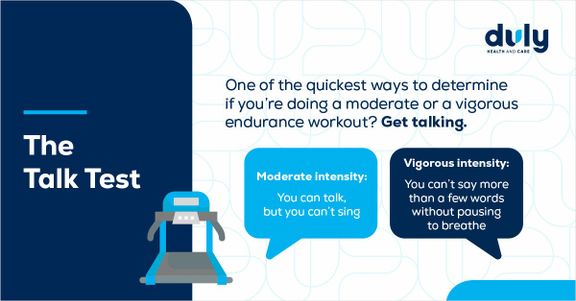When you think of exercise, what’s the first thing that comes to mind?
For some people, it’s getting their heart pumping by going for a run. For others, it’s weightlifting or taking a yoga class at a gym. Others do a series of stretches for each part of the body. You may wonder if one of these activities is better for your health than the others.
But none of these are the “better” or “worse” way to exercise. They each represent one of the four types of exercise: endurance, strength training, balance, and flexibility. An ideal workout routine combines all four of these areas, giving your entire body the exercise it needs.
Here is a deeper dive into what each of the four exercise types entails and how they benefit your health:
1. Endurance Exercise: Get Your Heartbeat Up
Endurance (“cardio” or “aerobic” exercise) increases your breathing and heart rate. It keeps your heart and lungs healthy and can help you lose or maintain weight, manage blood sugar, and improve overall fitness. An endurance exercise can be categorized as either moderate- or vigorous-intensity, depending on how hard your body works while doing it.

Each week, adults should get at least 75 minutes of high-intensity aerobic activity, at least 150 minutes of moderate-intensity activity, or a combination of the two. Don’t panic if you shudder at the word “cardio” — there are many ways to do endurance training, including:
- Moderate-Intensity
- Brisk walking (at least 3 miles per hour)
- Biking (less than 10 miles per hour on a flat surface)
- Ballroom dancing
- Gardening
- Tennis (doubles)
- Water aerobics
- Vigorous-Intensity
- Running or jogging
- Swimming laps
- Biking (at least 10 miles per hour or over hills)
- Tennis (singles)
- Heavy gardening (like continuous hoeing or digging)
- Hiking with a heavy backpack or uphill
If you need help finding the right type of exercise or treating an injury you got while exercising, make an appointment with a Duly Health and Care sports medicine provider.
2. Strength Training: Pump Those Muscles
Strength (or “resistance”) training is known for building and strengthening muscles, but it actually does much more.
It can help you develop stronger bones and slow down bone loss as you age, reducing the risk of the bone disease osteoporosis. It can also help you lose weight by increasing your metabolism so you burn more calories.
When strength training, you can use:
- Free weights
- Medicine balls
- Weight machines
- Resistance bands
- Your own body weight (e.g., push-ups or squats)
The American Heart Association recommends doing strength training for each muscle group at least two times per week, taking two days or more of rest in between workouts so your body can recover.
3. Balance Exercises: Stay Aligned
Balance exercises can give you stability at any age. However, it’s even more important as you get older. Over the years, you can lose muscle mass and strength, which may make you lose balance and become prone to trips and falls.
Adults ages 65 and older should incorporate balance exercises into their workouts, and those who are at high risk for falls should do so at least three times a week.
Many balance exercises can be done at home, without equipment, such as:
- Walking heel to toe in as straight of a line as possible
- Standing on one foot at a time
- Weight shifts:
- Stand with your feet hip-width apart
- Shift your weight to the right side of your body and then lift up your left foot
- Hold that position for as long as you can (up to 30 seconds)
- Go back to the starting position and repeat with the other side
You may also want to try yoga or tai chi, which is a form of movement training. If you don’t want to sign up for an in-person class, there are plenty of videos available online.
4. Flexibility Exercises: Stretch Out Your Body
Last but not least, the fourth category of exercise is flexibility, or stretching. These exercises stretch out your body, improving your range of motion and making your body more limber. Better flexibility can decrease your risk of injuries like joint and muscle strains, improve athletic performance, and reduce discomfort from being in a small space for a long period of time (like on a plane ride).
The American College of Sports Medicine recommends that healthy adults should do flexibility exercises at least 2 to 3 times per week that work all the major muscle-tendon groups (hips, legs, ankles, lower back, trunk, chest, neck, and shoulders).
Flexibility exercises can include classes like yoga or pilates or stretches that target specific muscle groups. You can find many stretches online (like through the American Heart Association), but it can be helpful to work with a physical therapist to choose the stretches that are best for your individual needs.
While flexibility exercises are a critical part of your physical activity regimen, it can be easy to overdo them or not use proper form — which could potentially lead to injuries. Keep these safety tips in mind:
- Don’t use stretching as a warm-up. Instead, warm up before stretching with a bit of light walking or jogging for 5 to 10 minutes.
- Keep stretches smooth and slow, and avoid bouncing or jerking.
- Stop stretching if you’re in pain (a little bit of pulling is okay)
- Make sure your joints are always slightly bent and loose, rather than locked into place.
- Stretch both sides of your body evenly.
Finding the Right Type of Exercise
There isn’t an exact formula, but the general recommendation is to make sure you’re getting in all four types of exercise. Beyond that, the type of exercise you need depends on many factors, such as:
- If you play a sport
- If you are recovering from an injury
- Your overall health
- Your personal goals, like losing weight or building muscle
- What you enjoy doing
Regardless of which type of exercise you choose, it’s always important to do them safely. Check with your provider if you have a medical condition like heart disease or if you’re recovering from an injury to make sure that you’re exercising in the safest and most effective way.
Health Topics:








